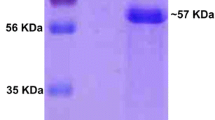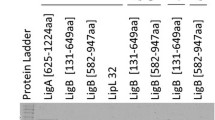Abstract
The present study is focused to express the recombinant Leptospira surface adhesion-44 (rLsa44) protein of pathogenic Leptospira interrogans serovar Pomona in Escherichia coli and its diagnostic application in the latex agglutination test (LAT) system to detect anti-leptospiral antibodies in the bovine sera. The Lsa44 protein-coding gene sequences were amplified, the purified amplicon was initially cloned into the pGEM-T Easy vector, and subsequently to the pETite vector for the expression of rLsa44 in Escherichia coli. After induction with 1 mM isopropyl-β-D-thiogalactoside (IPTG), the expressed recombinant protein with a molecular weight of ~42 kDa was purified by the Ni-NTA affinity chromatography, characterized by SDS-PAGE and confirmed by Western blot using Leptospira specific sera. The sensitized latex beads (0.8 µm) coated with rLsa44 protein were prepared and assessed for their suitability as a diagnostic antigen in the LAT. Ten microliters of sensitized beads were used with test serum for agglutination, the results were recorded for 3 min and positive results were rated as +++, ++, +, if the clumps appeared after 1, 2, and 3 min, respectively. The rLsa44-LAT was evaluated for detection of anti-leptospiral antibodies using known Microscopic Agglutination Test (MAT) with positive (n = 74) and negative (n = 91) samples from apparently healthy animals, which revealed the relative diagnostic sensitivity (DSn) of 88% and specificity (DSp) of 84%. Furthermore, on the evaluation of standardized rLsa44-LAT using MAT-tested sera (positive-62 and negative-64) from cattle associated with a history of reproductive disorder, a DSn of 94% and DSp of 91% were observed. The developed rLsa44-LAT is a simple and rapid test that can be applied as a diagnostic tool at the field level as an on-site test after its extensive evaluation. This first study describing the expressed rLsa44 protein in Escherichia coli and used as a diagnostic antigen in LAT for the detection of anti-leptospiral antibodies in the sera of bovine as a preliminary screening test for leptospirosis.




Similar content being viewed by others
REFERENCES
Faine, S., Adler, B., Bolin, C., and Perolat, P. Leptospira and Leptospirosis, Melbourne: Medisci Press, 1999, 2nd ed.
Haake, D.A. and Levett, P.N. Curr. Top Microbiol. Immunol., 2015, vol. 387, pp. 65–97.
Libonati, H.A., Santos, G.B., Souza, G.N., Brandão, F.Z., and Lilenbaum, W., Trop. Anim. Health Prod., 2018, vol. 50, no. 7, pp. 1625–1629.
Ellis, W.A., Vet. Clin. North Am. Food Anim. Pract., 1994, vol. 10 no. 3, pp. 463–478.
Grooms, D.L., Theriogenology, 2006, vol. 66 no. 3, pp. 624–628.
Lilenbaum, W. and Martins, G., Transbound. Emerg. Dis., 2014, vol. 61, pp. 63–68.
Pinto, G.V., Senthilkumar, K., Rai, P., Kabekkodu, S.P., Karunasagar, I., and Kumar, B.K., J. Microbiol. Methods, 2022, vol. 195, p. 106438.
Alamuri, A., Kumar, K.V., Kumari, S., Linshamol, L., Sridevi, R., Nagalingam, M., et al., Mol. Biotechnol., 2020, vol. 62, nos. 11–12, pp. 598–610.
Nagalingam, M., Thirumalesh, S.R., Kalleshamurthy, T., Niharika, N., Balamurugan, V., Shome, R., et al., Trop. Anim. Health Prod., 2015, vol. 47, no. 7, pp. 1329–1335.
Pinne, M., Choy, H.A., and Haake, D.A., PLoS Negl. Trop. Dis., 2010, vol. 4, no. 9, p. e815.
Chalayon, P., Chanket, P., Boonchawalit, T., Chattanadee, S., Srimanote, P., and Kalambaheti, T., Trans. R. Soc. Trop. Med. Hyg., 2011, vol. 105, no. 5, pp. 289–297.
Balamurugan, V., Thirumalesh, S.R.A., Alamuri, A., SowjanyaKumari, S., Kumar, K.V., Linshamol, L., et al., Lett. Appl. Microbiol., 2021, vol. 72, no. 6, pp. 730–740.
Haake, D. A. and Zückert, W. R., Curr. Top. Microbiol. Immunol., 2015, vol. 387, pp. 187–221.
Raja, V. and Natarajaseenivasan, K., Crit. Rev. Microbiol., 2015, vol. 41, no. 1, pp. 1–17.
Deneke, Y., Sabarinath, T., Gogia, N., Lalsiamthara, J., Viswas, K. N., and Chaudhuri, P., Mol. Cell Probes, 2014, vol. 28, no. 4, pp. 141–146.
Mariya, R., Chaudhary, P., Kumar, A.A., Thangapandian, E., Amutha, R., and Srivastava, S.K., Comp. Immunol. Microbiol. Infect. Dis., 2006, vol. 29, no. 5–6, pp. 269–277.
Senthilkumar, T. M., Subathra, M., Ramadass, P., and Ramaswamy, V., Trop. Anim. Health Prod., 2010, vol. 42, no. 2, pp. 217–222.
Smits, H. L., Hartskeerl, R. A., and Terpstra, W. J., Trop. Med. Int. Health, 2000, vol. 5, no. 2, pp. 124–128.
Alizadeh, S.A., Eshraghi, S.S., Pourmand, M.R., Naserpour, T., Abdollahpour, G., Rahimiforoshani, A., et al., Iran Red. Crescent. Med. J., 2014, vol. 16, no. 3, p. e14753.
Ye, C., Yan, W., McDonough, P.L., McDonough, S.P., Mohamed, H., Divers, T. J., et al., Clin. Vac. Immunol., 2014, vol. 21, no. 4, pp. 478–483.
Fernandes, L.G.V., Vieira, M.L., Alves, I.J., de Morais, Z.M., Vasconcellos, S.A., Romero, E.C., et al., Microbiology, 2014, vol. 160, pt. 1, pp. 149–164.
Balamurugan, V., Alamuri, A., Bharathkumar, K., Patil, S.S., Govindaraj, G.N., Nagalingam, M., et al., Trop. Anim. Health Prod., 2018, vol. 50, no. 5, pp. 1131–1138.
WOAH 2022. Manual of Diagnostic Tests and Vaccines for Terrestrial Animals, Paris: World Organisation for Animal Health (WOAH), 2022, pp. 1–13.
Balamurugan, V., Thirumalesh, S.R.A., Sridevi, R., Govindaraj, G., Nagalingam, M., Hemadri, D., et al. Proc. Natl. Acad. Sci. India Sect. B: Biol. Sci., 2016, vol. 86, no. 2, pp. 469–475.
Cole, J.R., Jr., Sulzer, C.R., and Pursell, A.R. Appl. Microbiol., 1973, vol. 25, no. 6, pp. 976–980.
Kelley, L.A., Mezulis, S., Yates, C.M., Wass, M.N., and Sternberg, M.J.E. Nature Protocols, 2015, vol. 10, no. 6, pp. 845–858.
Vita, R., Mahajan, S., Overton, J.A., Dhanda, S.K., Martini, S., Cantrell, J.R., et al. Nucleic Acids Res., 2019, vol. 47, no. D1, pp. D339–D343.
Guex, N. and Peitsch, M.C., Electrophoresis, 1997, vol. 18, no. 15, pp. 2714–2723.
Hull-Jackson, C., Glass, M.B., Ari, M.D., Bragg, S.L., Branch, S.L., Whittington, C.U., et al., J. Clin. Microbiol., 2006, vol. 44, no. 5, pp. 1853–1855.
ACKNOWLEDGMENTS
The authors wish to thank the Indian Council of Agricultural Research Institute (ICAR), New Delhi, India, for providing facilities, encouragement, and support. The authors also thank the ICAR-NIVEDI staff for their constant support and the Telangana state, Animal Husbandry and Veterinary Services Departments and their officials, field veterinarians, and para-veterinarians for submitting the samples to ICAR-NIVEDI for diagnosis of leptospirosis by MAT. The authors, also thank Mr. S. Ashraf for his kind help in doing the modelling and epitope prediction of the Lsa44 protein. The first author, also thank the staff of the Department of Microbiology, Veterinary College, Hebbal, and College of Veterinary Science, Korutla, for their constant support.
Funding
This research work is part of the Ph.D. program of First Author, and the research project work was carried out in ICAR-NIVEDI and funded by the Institute project (IXX15283).
Author information
Authors and Affiliations
Corresponding author
Ethics declarations
Statement on the welfare of animals. This study was carried out in the approved institute Project (F. no. 6-52/NIVEDI/Biosafety/2019/10/05 dated 07.09.2021) by the Institutional Biosafety Committee (IBSC). The animal sera from various disease investigation units of the state animal husbandry departments or veterinary colleges in Telangana state were submitted to the ICAR-NIVEDI for providing diagnosis for Leptospirosis by MAT. These available sera in the Leptospira Laboratory were used in this study. The manuscript does not contain animal experimental trials. Moreover, the serum samples were collected by well-trained veterinarians concerning animal welfare regulations for disease diagnosis after obtaining oral concern from the animal /farm owners.
Conflict of interest. The authors declare that they have no conflicts of interest.
Supplementary Information
Rights and permissions
About this article
Cite this article
Menamvar, S., Bokade, P.P., Kumar, K.V. et al. Production of Recombinant Leptospira Surface Adhesion-44 Protein in Escherichia coli and Its Diagnostic Application in the Latex Agglutination Test for the Detection of Anti-Leptospiral Antibodies. Appl Biochem Microbiol 59, 723–732 (2023). https://doi.org/10.1134/S0003683823050113
Received:
Revised:
Accepted:
Published:
Issue Date:
DOI: https://doi.org/10.1134/S0003683823050113




